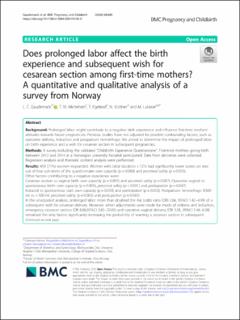| dc.contributor.author | Gaudernack, Lise Christine | |
| dc.contributor.author | Michelsen, Trond Melbye | |
| dc.contributor.author | Egeland, Thore | |
| dc.contributor.author | Voldner, Nanna | |
| dc.contributor.author | Lukasse, Mirjam | |
| dc.date.accessioned | 2021-11-18T08:55:47Z | |
| dc.date.available | 2021-11-18T08:55:47Z | |
| dc.date.created | 2020-10-22T16:11:13Z | |
| dc.date.issued | 2020 | |
| dc.identifier.citation | BMC Pregnancy and Childbirth. 2020, 20:605 1-13. | |
| dc.identifier.issn | 1471-2393 | |
| dc.identifier.uri | https://hdl.handle.net/11250/2830222 | |
| dc.description.abstract | Background Prolonged labor might contribute to a negative birth experience and influence first-time mothers’ attitudes towards future pregnancies. Previous studies have not adjusted for possible confounding factors, such as operative delivery, induction and postpartum hemorrhage. We aimed to determine the impact of prolonged labor on birth experience and a wish for cesarean section in subsequent pregnancies. Methods A survey including the validated “Childbirth Experience Questionnaire”. First-time mothers giving birth between 2012 and 2014 at a Norwegian university hospital participated. Data from deliveries were collected. Regression analysis and thematic content analysis were performed. Results 459 (71%) women responded. Women with labor duration > 12 h had significantly lower scores on two out of four sub-items of the questionnaire: own capacity (p = 0.040) and perceived safety (p = 0.023). Other factors contributing to a negative experience were: Cesarean section vs vaginal birth: own capacity (p = 0.001) and perceived safety (p = 0.007). Operative vaginal vs spontaneous birth: own capacity (p = 0.001), perceived safety (p < 0.001) and participation (p = 0.047). Induced vs spontaneous start: own capacity (p = 0.039) and participation (p = 0.050). Postpartum hemorrhage ≥500 ml vs < 500 ml: perceived safety (p = 0.002) and participation (p = 0.031). In the unadjusted analysis, prolonged labor more than doubled the risk (odds ratio (OR) 2.66, 95%CI 1.42–4.99) of a subsequent wish for cesarean delivery. However, when adjustments were made for mode of delivery and induction, emergency cesarean section (OR 8.86,95%CI 3.85–20.41) and operative vaginal delivery (OR 3.05, 95%CI 1.46–6.38) remained the only factors significantly increasing the probability of wanting a cesarean section in subsequent pregnancies. The written comments on prolonged labor (n = 46) indicated four main themes: Difficulties gaining access to the labor ward. Being left alone during the unexpectedly long, painful early stage of labor. Stressful operative deliveries and worse pain than imagined. Lack of support and too little or contradictory information from the staff. Conclusions Women with prolonged labors are at risk of a negative birth experience. Prolonged labor per se did not predict a wish for a cesarean section in a subsequent pregnancy. However, women with long labors more often experience operative delivery, which is a risk factor of a later wish for a cesarean section. | |
| dc.language.iso | eng | |
| dc.title | Does prolonged labor affect the birth experience and subsequent wish for cesarean section among first-time mothers? A quantitative and qualitative analysis of a survey from Norway | |
| dc.type | Peer reviewed | |
| dc.type | Journal article | |
| dc.description.version | publishedVersion | |
| dc.source.pagenumber | 1-13 | |
| dc.source.volume | 20:605 | |
| dc.source.journal | BMC Pregnancy and Childbirth | |
| dc.identifier.doi | 10.1186/s12884-020-03196-0 | |
| dc.identifier.cristin | 1841607 | |
| cristin.ispublished | true | |
| cristin.fulltext | original | |
| cristin.qualitycode | 1 | |
